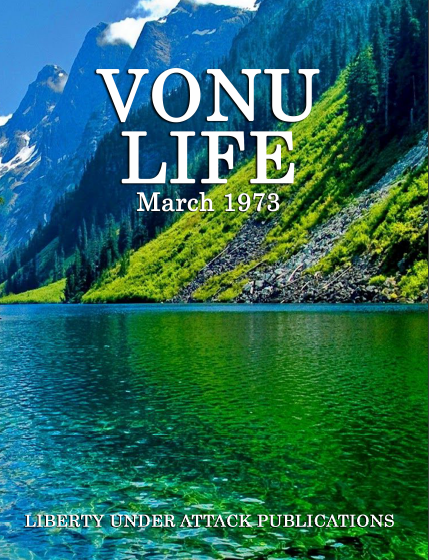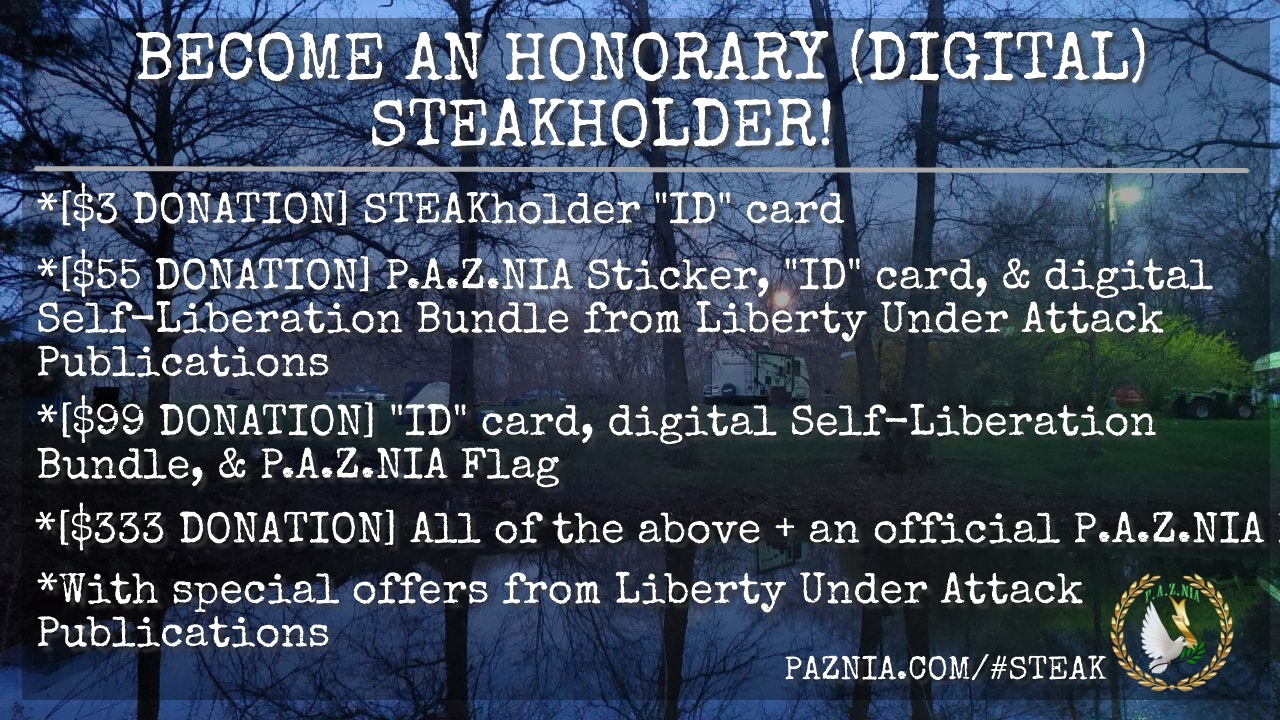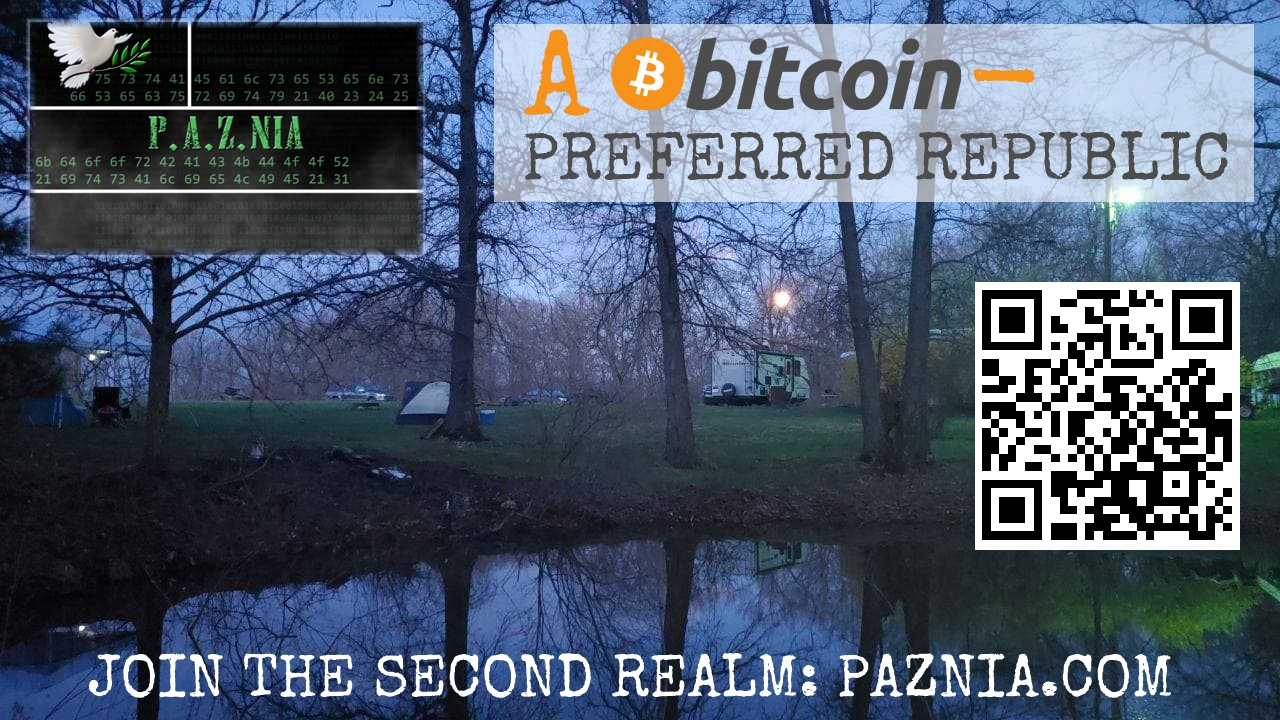Podcast: Play in new window | Download
Subscribe: Apple Podcasts | Android | Email | Google Podcasts | Stitcher | TuneIn | Spotify | RSS
On this episode of The Vonu Podcast, you’ll catch two more stellar articles from VONULIFE (this time, #8).
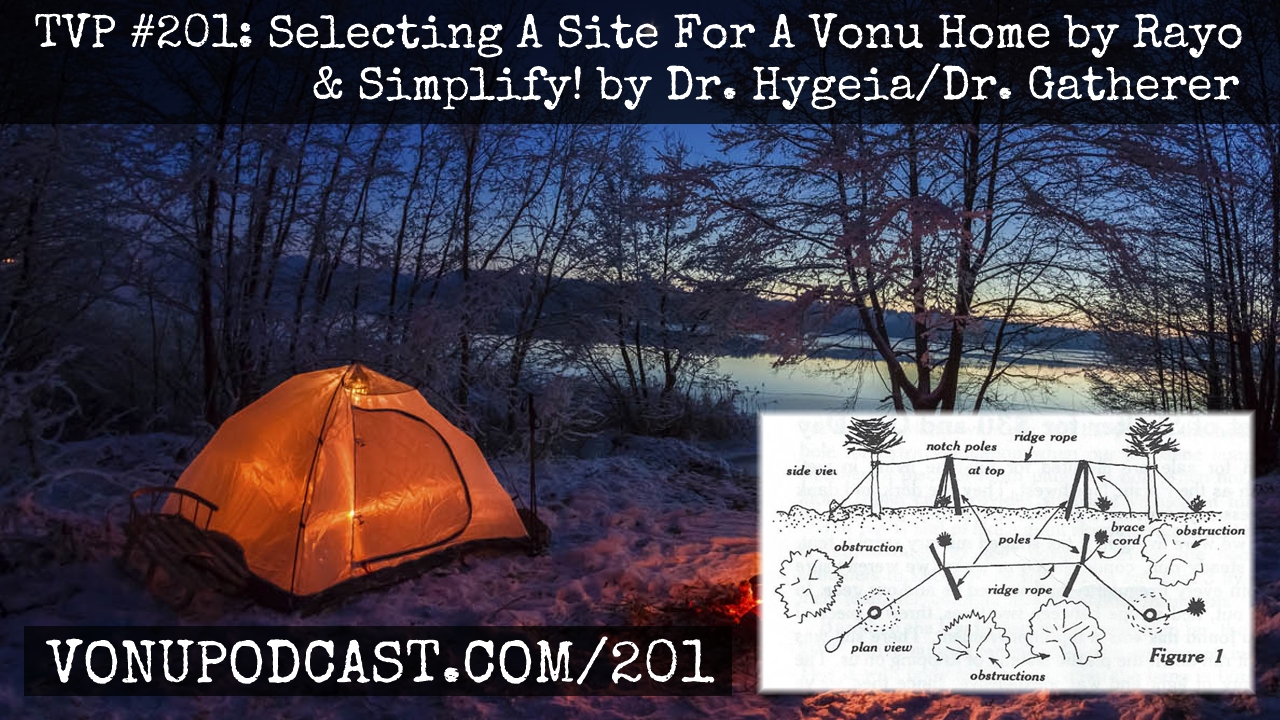
One by Rayo on selecting a site for a vonu home, the other by Dr. Gatherer/Dr. Hygeia on ways she simplifies her life to make time for things she wants to do most.
Keep a lookout later this year for the entire VONULIFE collection, issues 1-16.
SELECTING A SITE FOR A VONU HOME
Desirable attributes of a site depend on living patterns, type of shelter, permanency, overall geography, and other factors. Use the following only as a guide for developing your own checklist.
TERRAIN – I prefer slopes and tributary valleys. Most human off-road travel is along ridges and the bottoms of main valleys, where the ground is relatively level and there is little brush. (During seasonal floods, many valley streams sweep clear channels wider than their usual courses.) Also: ridges are exposed to wind and lightning: food, cold air, and mosquitoes often lay in valleys.
SLOPE – In MUCH OF Siskiyou region, there is little level land except on valley floors and ridges. So I would choose a type of shelter which can be built on at least a 20% slope (one foot rise per five feet horizontal).
On sloping ground, a level surface, such as a bad foundation, requires either digging out or building up. If the slope is steep, disposing of dug-out dirt may be difficult; unless a retaining wall is built, the dirt will slide a long way and be conspicuous. For a big structure on a steep slope, I would plan on multi-split-levels.
On slopes steeper than 30% the only suitable shelter may be a treehouse or a cabin on pilings. This is providing trees and brush are sufficient to screen a raised structure: vegetation is usually less on a steep slope.
Fortunately, in most areas slopes are irregular; moderate inclines and sometimes near-level benches alternate with steep places.
SOIL – If my shelter requires much digging, I would avoid extremely rocky ground (especially outcrops of bed rock) unless I were using hard-rock mining techniques to bore a tunnel. If digging isn’t necessary I might choose a rocky place so that I can use the rock in construction.
BRUSH will discourage intruders or give warning of their approach. People tend to walk where the walking is easy so a few hundred yards of heavy brush on a steep slope may keep them away more effectively than several miles of open level ground.
On the other hand in heavy brush areas, I have to find/make trails and arrange/maintain them so that strangers cannot easily follow them. But once I do, I enjoy a big advantage over any intruder.
I enjoy having a few relatively-open-and-level spots near my home for play or lounging. But most brushy areas have a few openings.
All in all, I prefer brush if my shelter is relatively permanent and access is by foot only; open woods or meadows for temporary camps and van living.
TREES provide concealment from the air. And in Summer they offer cooling shade. On the other hand, they block solar heating in Winter, increase hazard in event of forest fire (so does brush), and, if large conifers, may attract logging.
In very few areas of Siskiyou is tree foliage dense enough to completely hide an un-camouflaged structure. But even light foliage obscures; partial shade breaks up outlines.
Evergreen trees and bushes are best. In Siskiyou most are evergreen; broadleaf as well as conifer.
Spotting of small ground objects from the air is not as easy as some think. Many times I have attempted to spot my own shelters from nearby hills. But even with a stable-supported telescope, and knowing what I was looking for and where to look, I was often in doubt. And this was with poorly camouflaged tents.
Now and then the bludg plant a story about some new spy satellite to awe their subjects. But their claims, if truthful, assume ideal conditions such as a man dressed in white on a black-asphalt parking lot.
Lights at night are something else. Even a candle flame is visible for miles on a clear, moonless night. But lights can be blocked with opaque material in the structure itself. Another no no is a smoky fire during daylight.
I check for dead trees and large dead limbs which might blow down in a storm. I pull these down before they cause trouble.
DISTANCE – The less accessible my area is to outsiders, the less accessible their supply and communication channels are to me. The pros and cons tend to balance.
I like to be at least a hundred miles from a large city to minimize fallout danger and to reduce number of recreation seekers; few people will drive more than 200 miles during a weekend. On the other hand, I like to be within a half-day’s travel of a town of 5000 population minimum for communication purposes.
I try to locate at least a mile from any residence or popular campground; children and their dogs, who are the most foot-mobile members of that society, seldom go more than a mile cross-country on their own; their parents mostly stay on the roads or, if “roughing it”, on official trails. Distance minimizes chances of cooking smells or noises being detected. I like to be at least a quarter mile from any road.
Noise is a big consideration. If one insists on keeping a dog, cutting wood with ax or power saw, or shooting close to home, perhaps no place in Siskiyou is sufficiently remote.
A point against remote location: if a structure, vehicle, or person should be spotted form the air, it will arouse less curiosity if it is where people are known to be.
I prefer to locate my roadhead (where I unload supplies from a vehicle), base camp, water source, stashes and any other facilities all on the same side of a road, so that road crossing is minimal. If this isn’t possible, I pick crossings away from creeks so that I will hear approaching vehicles before they can see me.
I look for human debris such as beer cans and shotgun shells to ascertain how much an area is frequented. But there are logged-over areas, with much debris left from time of logging, which may not be frequented again until new growth is ready for thinning, which may be in 30 to 60 years.
ACCESS – I am interested in two kinds: seasonal access to bring in heavy supplies once a year; year-around access for communication.
Since I am not living off the land, I pack in over 500 pounds of supplies per person per year, plus initial equipment. So distance of site from the nearest roadhead is a big cost factor. Assuming 50 pounds average load (some items may be bulky and awkward), one mph average speed over a rough trail, 500 pounds of supplies per year, and 1000 pounds of initial gear with change of base every two years: for every mile of distance I will spend 40 hours per year backpacking. In addition, I may spend 20 hours initially scouting and clearing trail. This assumes no average grade no greater than 20% – i.e., 1000 feet elevation change per mile. I would estimate each additional 100 feet vertically to be equivalent to an extra mile in distance.
Beyond a certain distance, remoteness may actually decrease vonu – the longer the access trail, the greater change of encountering someone or of the trail being identified by a skilled tracker.
The roadhead doesn’t have to be on a paved road; a rough trail which a truck can drive with difficulty in summer (or maybe a snowmobile in winter) is sufficient. Or I might rent an all-terrain vehicle once a year. (I haven’t yet.) I find a roadhead which is out of sight of the road. Or I unload late at night on a rainy night. Or I unload openly during the day but have a cover story in case anyone is curious.
A roadhead is better located if not at the end of the road, since recreationists tend to drive until they can drive no more and then walk until they get tired.
The year-around communication trail may be only a foot trail. Some considerations: Does it cross a creek which will require special equipment for safe crossing during wet seasons? Is part of it at an elevation where snowshoes will be needed in Winter? – which might be an advantage or disadvantage.
WATER for drinking and cooking. Is a creek or spring close by? Does it flow the year around? If not, will a shallow well reach water? Will the water need purification?
If I can carry 10 gallons (about 80 pounds) of water at one mph (average for round trip) and I use five gallons per day for drinking, food preparation, dish washing, and hand washing; each 100 yards distance from a water source will cost me 20 hours per year.
If I expect to occupy a site for several years, I would consider laying plastic pipe from the closest uphill source. Half-inch polyethylene pipe costs about $7 per 100 yards, plus time spent purchasing, packing in, laying in shallow ditch, and covering. (The ditch is for concealment; most poly pipe will not burst if the pipe freezes.)
Are there latrine areas which are downhill from or well away from the water source? If a person uses a square foot of area each day and an area is reused every two years, 700 square feet (about 20 by 35 feet) will be needed.
WATER for bathing, laundry, and perhaps hydroelectric power. I will most likely take myself and my clothes to the water for washing, so distance is not so critical. Is there a pool being enough to immerse my body? If not, I can lay hose along a creek until have over six feet of head, start the water siphoning, and have a shower (also handy for filling water cans).
At a permanent home site I would like sufficient water power so that, at a later time, I could install a small impulse turbine capable of driving an auto generator and recharging batteries. This is a subject for a separate article.
QUIET – absence of wind and water noise. Away from open plains, ridges and passes, wind is rarely a problem. But a large creek is noisy. Water sounds not only mask other sounds I want to hear but become irritating after awhile. On the other hand, water noises may mask my sounds from outsiders.
Perhaps I can locate where there is a bench or the shoulder of a hill between the site and the creek. Or maybe there is a small brook or spring which doesn’t make much noise. If the brook doesn’t flow part of the year, I must walk further then.
If my dwelling is mostly or entirely underground, noise may not be a problem.
RAINFALL – Advantages of a high rainfall area: availability of water; ample brush and trees where soil is fair; eradication of tracks; unattractiveness to most people. Disadvantages: materials rot or rust if not protected; special clothing is needed; wet clothing is difficult to dry; rain noise can mask other noises; soil is leached of minerals. Vehicle trails, such as old logging or mining roads, soon wash out or grow over, which may be an advantage or disadvantage depending on one’s way of life.
When I first moved to Siskiyou from S. Calif., I dislike the long rains. But, as I obtain suitable shelter and clothing, I enjoy the increased seclusion.
ELEVATIONS and direction of slope. The lower the elevation and the more southerly the exposure, the warmer the climate and the less time snow remains on the ground. In Siskiyou, below 2500 feet, snow does not remain on the ground for more than a few weeks during most Winters. On a south-facing slope, snowline may be 1000 feet higher than on a north-facing slope.
Snow shows tracks, which is helpful when hunted but not when being hunted. Areas with much brush and rocks but many trees will be more accessible in Winter if the rocks and brush are buried under several feet of snow. Areas with small trees close together will be less accessible.
For now, at least, I prefer to locate my base camp where there is relatively little snow. But snow can be an advantage for those who learn to work and live with it.
CULTURE of natives. If I were completely self-sufficient this wouldn’t matter much. But if I engage in outside trade and communication, I am less conspicuous and therefore more vonu in a country where I know the language and customs – where I can pass as a native.
GENERAL: I do not expect to find an ideal spot. Attributes often conflict: a spot with good tree cover will not be sunny; a spot close to water may be noisy.
When comparing sites I try to estimate the cost of the various factors in man-hours per year. If one site is more remote, how many additional hours will I spend packing in supplies? If another site is less secluded, what is the additional probability per year of loss due to discovery, and how much will I probably lose? If I prefer the view or other aesthetic feature of a site, how many hours of work per year would I pay for it?
When converting money costs to man-hours I consider not merely the wage I can earn in a job outside but the indirect costs of such a job. Perhaps in Los Angeles I can earn $5 per hour clear. But, when I include risk of nuclear attack while I am there, degradation of health by smog, travel expense, city shelter expense, time spent looking for job, and other risks and discomforts, maybe the subjective costs of one hour work in Los Angeles are great as the subjective costs of ten hours of monotonous work in a vonu place. So I will figure my time in vonu as 50¢ per hour.
What is a good shelter partly depends on the terrain. So I do not finalize a design until I select a site. But I think through several kinds of shelter in advance so that I can better identify likely areas and spots.
I try to design a shelter for terrain and vegetation that is typical of a region, rather than find a unique spot suitable for a particular shelter. For example, if trees are generally sparse in an area, I would build a low, heavily-camouflaged structure, rather than erect a dome in one of the few dense groves.
In each area I try to pick at least one specific site. Then, when comparing areas, I can compare site against site as well as comparing areas in general.
When scouting I make one-day trips from a base camp. To go further, I move base camp. Two or three day trips are uneconomical because, with weight of bedding and food, I cannot cover two or three times the area.
A conventional, un-camouflaged shelter is not without its advantages; not only is it easier to build, but, if discovered, it will arouse less curiosity. Especially at a temporary camp, camouflage may not be worthwhile. On the other hand, there are many possible explanations for a concealed structure: fear of private marauders, especially when a woman is there alone; study of particular plants which grow in the area; conservationist desire to alter appearance of an area as little as possible; warmth of an underground structure. –RAYO
[SECOND ARTICLE CONTINUES BELOW]

EMAIL [email protected] & SEE HOW WE CAN HELP YOU SHARE YOUR STORY!
HYGEIA’S HYGIENIC REVIEW: SIMPLIFY
by Dr. Hy
I want to have as much time as possible for the things I like to do most. That’s why I try to spend as little time as possible doing other things. Here’s how I do it:
DRESSING: I don’t wear clothes! Except as protection against the elements: cold, extreme sun, brambles, bugs, and bludg. I never wear a bra or girdle and usually dispense with all underwear. For economy, most of my clothes come from thrift stores and/or the dump. The less money I spend, the less time I must spend earning it, at work I may not like.
The clothes I do wear, I don’t iron. So I wear a few wrinkles. That way, I keep my wrinkles removable.
GROOMING: I don’t use toothpaste. Water suffices except for an occasional scrub with baking soda/dental pumice. Price (Nutrition and Physical Degeneration) observed perfect teeth and gums in peoples who never brushed, though they did have deposits on their teeth.
I don’t use a deodorant. I do wash. I use water and friction lavishly, but soap sparingly since its alkalinity interferes with the skin’s protective acidity.
I don’t use make-up. In addition to being a big nuisance, lipstick may have carcinogenic coal tars, mineral oil leaches oil soluble vitamins form the body, powder clogs the pores, and perfumes often contain the products of what I consider needlessly slaughtered animals. Furthermore, my lover likes me a la natural. (Maybe that’s one of the reasons why I like him!)
I don’t cut my hair nor shave my legs or underarms. I do brush my hair one hundred strokes or more each day and give my scalp a finger massage. I find this minimizes the number of shampoos necessary.
PLUMBING: I don’t have any. I pee in a coffee can (the plastic lid’s nice – doesn’t rust) and I shit in the ground. I don’t mean a dark, smelly outhouse either. I just shovel a hole each time I need one, under the blue sky. (If you live in the city this method would pose problems; but who says you have to live in the city?)
For water, my system consists of a couple of five gallon pails or a few one gallon bleach jugs plus me. (The me part walks the containers to the creek, fills them, and brings them home.)
POSSESSING: I strive to have a minimum of material possessions. If I must spend a good deal of my time transporting, maintaining, keeping track of and fretting over labor saving devices, they become more labor engendering than saving.
I’m still eliminating junk acquired to become a non-consumer. Now, before adding any item to my impedimenta, I ask myself “Do I need it? For basic survival?” Probably not! But if I still feel like I want it, I ask myself, “Will I use it?” “Will it give pleasure for a long time or become a piece of clutter as I grow tired of it?” (E.g., I was recently tempted to buy some disposable plastic gloves to protect my hands while doing certain jobs. But I decided not to buy them because I already have plastic bags which I found could double as gloves, even though they don’t fit perfectly. This was, I avoided one more item to buy and keep track of.) NO NEED FOR TWO WHEN ONE WILL DO.
I don’t try to possess any land. I prefer to use it instead. This way, Mother Nature serves as my landlord, gardener, game keeper, and swimming pool attendant.
CLEANING AND NEATING: Cleanliness and neatness are becoming less and less ends in themselves for me. Whiter than white and brighter than bright are part of the compulsive, conspicuous consumption society. I prefer “clean enough to be healthy, dirty enough to be happy;” neat enough to be accessible, messy enough to be usable.
EATING: Often I don’t. I fast (i.e. just imbibe water, period) for two days each week, and for four or more days now and then. When I do eat, I strive to make it only one, at most two meals a day. (Otherwise, I get fat.)
Less eating means less time devoted to food, in all its many aspects; such as planning, procuring, storing, preparing, and dining, not to mention time spent earning the money to buy it. Not that I begrudge food time, quite to the contrary, but I’ve found that by eating less I enjoy it more; I personally have to be very careful least food run my life, and that’s what I don’t want.
COOKING: I spend relatively little time cooking, instead I eat many foods just as they come from nature (minus any dirt). I do this to conserver nutrients, which I feel are necessary for health.
When I do cook, I seldom use oil. I think it’s healthier to get my essential fatty acids form whole vegetable foods such as seeds and nuts. This, coupled with eating little meat makes dishwashing a breeze. (For popping corn without oil, see VL6; bread baking without oil, see VL3.)
MEDICATING: The only pills I take are some vitamins. I don’t seek any treatments from medics, surgeons, psychiatrists, or any other practitioners. If any practicing is to be done on me, I’d just as soon do it myself.
BELIEVING:
Some people believe in God.
I believe in myself.
Therefore, I must be God!
ARGUING: I try not to argue. Why argue? If it’s something very important to me at stake and the other person doesn’t see my way I figure we’d best go our separate ways. If it’s something less significant, I try to simply state my point of view and let the other person agree or not, as he will.
ENTERTAINING: I don’t have a T.V. and seldom go to the movies (like maybe once last year). I do own a radio: in weaker moments, I listen to it. Most of the values conveyed by these media re repugnant to me. They are the values of a sick, sadistic, stifling, straight-jacket society. Of the good things shown on film, I rather do them than watch someone else. The greatest adventure in life is living and I figure I can’t do it through somebody else. (Upon rereading, that sounds rather-overgeneralizing: a movie could be beautiful, inspirational, and educational. And I do watch other people in books, if not in movies.
QUOTING: “The more you quote, the less quotable you are.” –THE WISE OLD UNQUOTABLE SAGE.
All the don’ts may sound negative, but because I don’t do all the foregoing, I’ve actually created more time for the positive, the things I most enjoy.
Strange as it may seem, it’s been just as difficult deciding what those things are as making time for them. I’m sorry to say that I’ve spend many years letting others decide what I would do with my time. First it was parents and teachers, then professors. Would you believe I ever considered joining the WACS?! There was also a psychiatrist to top this off. (He thought I should wear make-up. Sure, paint a smile on my face. Worked about as well as the pills he gave me.) But I’m happy to say that is behind me. Now I mange (or mismanage) my time myself. May you also. And may you peacefully live the life you envision.
SIMPLY, DO YOUR OWN THING.
HEALTH LIBERATION/SELF-LIBERATION SPECIAL OFFER:
The Amazing AquaCure!
Interested in your own AquaCure? Save $125 with coupon code “vonu“, and help support the P.A.Z.NIA Department of Health/Wellness at the same time!
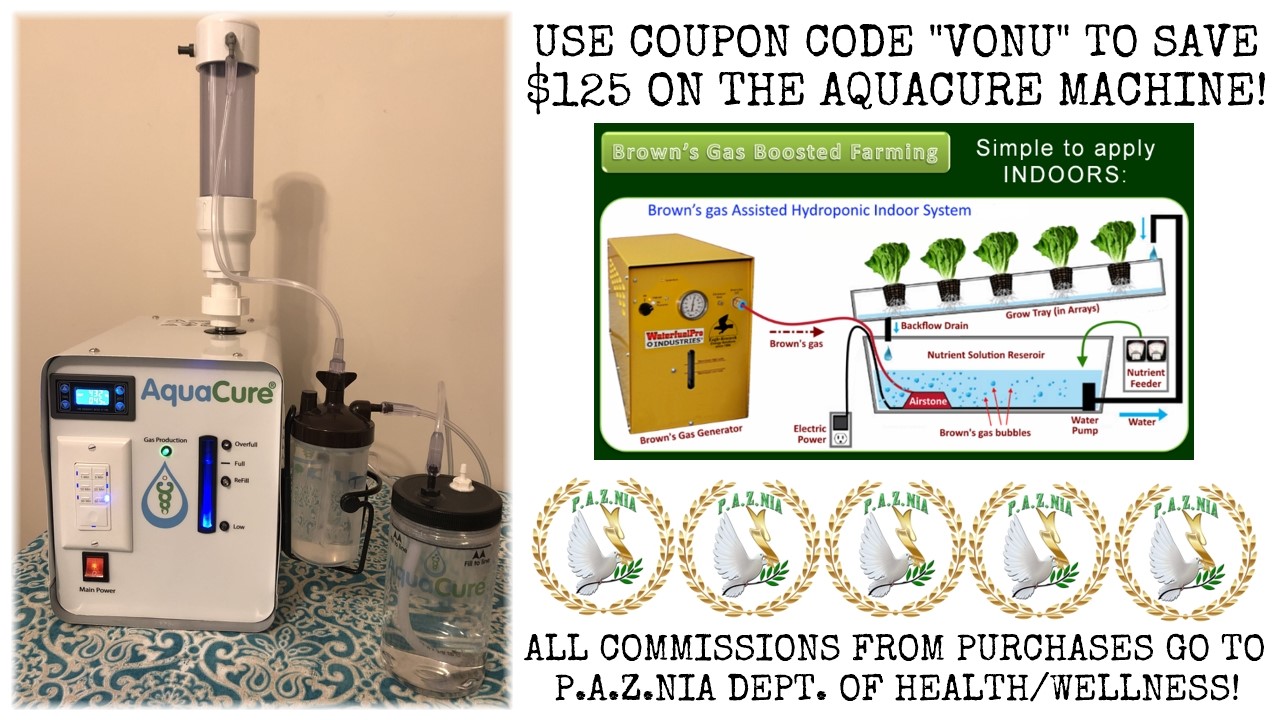
THE DIGITAL HOME OF #THEFREEREPUBLIC
